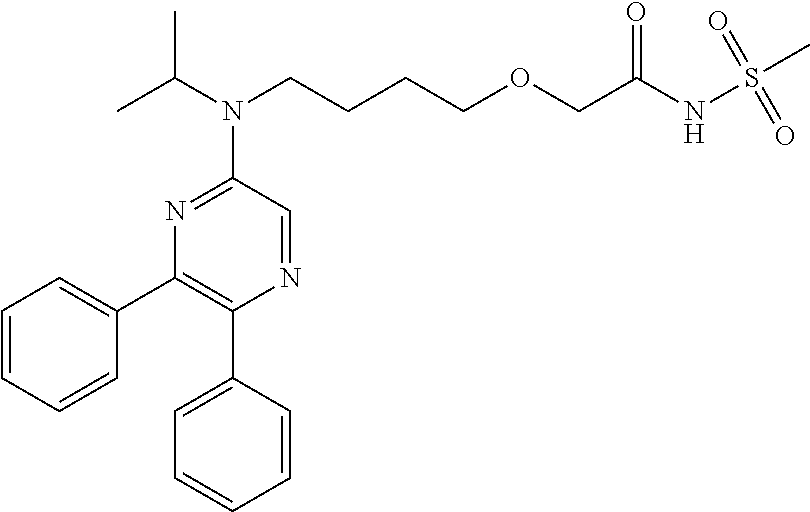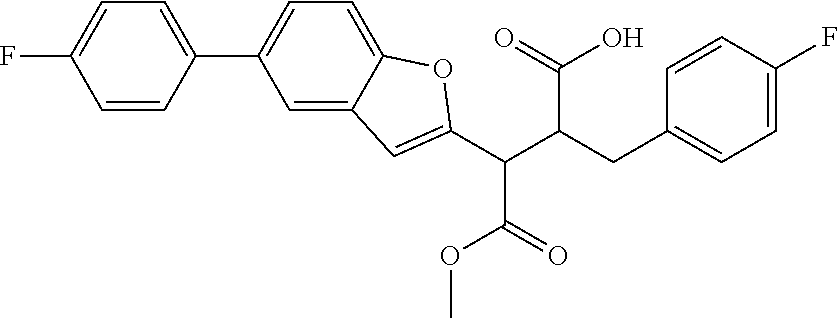Inhibition of neovascularization by inhibition of prostanoid IP receptors
a prostanoid ip receptor and neovascularization technology, which is applied in the direction of biocide, drug composition, and active ingredients of elcosanoid, can solve the problems of significant loss of central vision, leakage, bleeding, blindness, etc., and achieve the effect of decreasing neovascularization and decreasing neovascularization
- Summary
- Abstract
- Description
- Claims
- Application Information
AI Technical Summary
Benefits of technology
Problems solved by technology
Method used
Image
Examples
example 1
Investigation of VEGF Secretion and Inhibition in Culture
[0057]A TNFα-stimulated human macrophage system was employed, as known in the art, to assess the effect of IP receptor agonist and IP receptor antagonist on induction of VEGF secretion. As depicted in FIG. 1A, cicaprost dose dependently induces VEGF secretion in TNFα-stimulated human macrophages with EC50=2.3 nM.
[0058]In order to test whether a IP receptor antagonist can reverse the effect of cicaprost-induced VEGF secretion in TNFα-stimulated human macrophages, the IP receptor antagonist Formula I was employed. As depicted in FIG. 1B, Formula I dose dependently inhibits the secretion of VEGF in TNFα-stimulated human macrophages which can been exposed to 100 nM cicaprost. The human macrophages had been obtained from two separate donors, as indicated in FIG. 1B.
example 2
Investigation of Blockade of IP Receptors in Laser-Induced CNV
[0059]A laser-induced model of CNV was employed, as known in the art, to determine whether blockade of IP receptors alone is sufficient to inhibit CNV. See e.g., Francois et al., 1975, Am. J. Ophthalmol. 79:206-210; Edelman & Castro, 2000, Exp. Eye Res. 71:523-533; Goody, R. J., et al., 2011, Exp. Eye. Research 92:464-472.
[0060]Test rats were administered laser treatment after which vehicle (50% propylene glycol in H2O) or IP receptor antagonist Formula II was administered. The area of subsequently identified CNV was quantified by methods known in the art. As shown in FIG. 2A, the area (μm2) of CNV was significantly reduced per test subject after administration of IP receptor antagonist. As depicted in FIG. 2B, the area of CNV was also reduced as judged by a comparison of each eye. Moreover, as depicted in FIG. 2C, the area of CNV was reduced on a per lesion basis.
PUM
| Property | Measurement | Unit |
|---|---|---|
| Structure | aaaaa | aaaaa |
Abstract
Description
Claims
Application Information
 Login to View More
Login to View More - R&D
- Intellectual Property
- Life Sciences
- Materials
- Tech Scout
- Unparalleled Data Quality
- Higher Quality Content
- 60% Fewer Hallucinations
Browse by: Latest US Patents, China's latest patents, Technical Efficacy Thesaurus, Application Domain, Technology Topic, Popular Technical Reports.
© 2025 PatSnap. All rights reserved.Legal|Privacy policy|Modern Slavery Act Transparency Statement|Sitemap|About US| Contact US: help@patsnap.com



